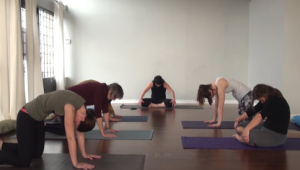Yoga has come a long way in the past 50 years.
Once regarded as pseudo-treatment operating on the fringe and lacking in scientific value, yoga has found mainstream acceptance and has been incorporated into medical and psychiatric therapies.
New research even shows that yoga – a physical, mental and spiritual practice – goes deeper than muscular flexibility and strength to address trauma and even chronic pain.
This type of yoga is called trauma-centered or trauma-sensitive yoga, and it’s nothing like what you’ve seen at your nearest gym, says Dallas Adams, a licensed social
worker and certified yoga teacher at the Menninger Clinic in Houston, which provides research, treatment and education for psychiatric illnesses.
The clinic is pioneering trauma-sensitive yoga as an adjunct therapy for sufferers of chronic pain and post-traumatic stress disorder. Adams, who has practiced yoga for 15 years, started conducting the sessions for Menninger patients early this year.
Adams says that trauma victims often don’t feel safe because of violent physical or sexual assault and have lost a sense of control over their own bodies.
Trauma-sensitive yoga takes people where they are and puts them in control of the treatment. It’s safe, and it has really good outcomes,” Adams said. “That really hit me.”
A 2014 study conducted by researchers at the Trauma Center at the Justice Resource Institute in Brookline, Mass., and published in the Journal of Clinical Psychiatry tested trauma-sensitive yoga on 64 women who had been raped or violently physically assaulted.
Existing methods of treating women with PTSD – using medication and cognitive behavior therapy – has a high rate of failure. For example, one recent study showed that 59 percent still had PTSD after 12 weeks of treatment.
The newer research using yoga included 64 women with chronic, treatment-resistant PTSD. They were assigned to either a control group with a health-education class or a group that practiced trauma-informed yoga; both groups met in weekly one-hour sessions for 10 weeks.
Researchers found that 52 percent of the yoga participants no longer met the criteria for a PTSD diagnosis after treatment, compared with 29 percent of the control group. Their conclusion was that the yoga had helped the women tolerate physical and sensory experiences connected to the fear and helplessness of their trauma.
Without treatment, such PTSD sufferers remain disconnected from physical sensations, and common daily actions or events can trigger or reignite their pain all over again. Instead of living in this vicious cycle, Adams said that patients can choose to accept the yoga experience and allow whatever physical response that arises.
The reconnection of body and mind can be a powerful healing experience, he said. When he leads classes, Adams says he uses language that helps patients re-establish choice and gain control over their bodies in a safe environment.
For example, patients are “asked,” or “invited” – never “instructed” – to join a particular yoga form. “Pose” is another word that any weekend-yogi is familiar with and would expect to hear in a class.
In trauma-sensitive yoga, however, the word “pose” may be a trigger for some who have been forced into physical poses in abusive situations. Instead, “form” or “shape” are preferred words, Adams said.
Adams said he also doesn’t perform physical assists, as in typical yoga, and he doesn’t look at patients as they execute the forms because there is no wrong or right way to do them.
Though trauma-sensitive yoga may be part of a client’s therapy, it doesn’t involve conversation about the actual trauma, he said. “The only reason for form is to experience the sensation,” Adams said. “We come in, we do yoga, we leave.”
At Menninger, a member of the treatment team must refer the patient to the yoga class, and patients must be in some other form of therapy simultaneously.
“It’s one piece of a much more complicated intervention,” said Dr. Alok Madan, a McNair Scholar and senior psychologist at Menninger, and associate professor in the Menninger Department of Psychiatry and Behavioural Sciences at Baylor College of Medicine.
Although every yoga studio won’t have an instructor on staff who has trained at the Justice Resource Institute, – the certifying body most recognised within the medical community – Madan says that a general yoga practice at home, or in a yoga studio, can still be beneficial for someone suffering from PTSD or chronic pain because so many of the benefits are the same.
For chronic pain sufferers, he noted that standard treatment approaches – chiefly opioids or painkillers – have failed many people and can be addictive.
“I don’t think they (trauma or chronic pain sufferers) have been offered best practices. I think a lot of best practices are hidden gems that are not available,” said Madan of the value of this specialised yoga.
Based in Sydney, your TCTSY Facilitator Esther is one of the first yoga teachers in Australia to be certified in Trauma Center Trauma Sensitive Yoga. For more information please call 0424 622 914 or email esther@beside.consulting.au
By J. Jones






Leave A Comment